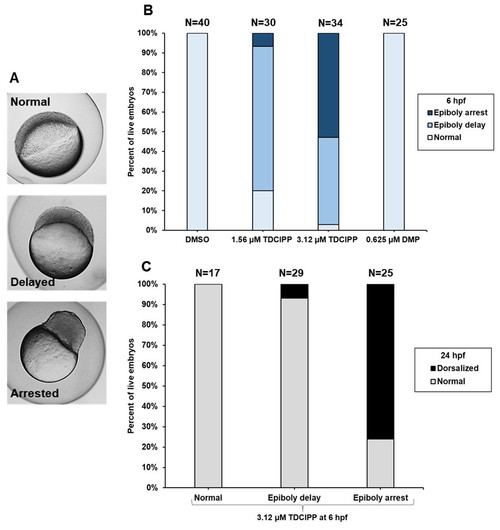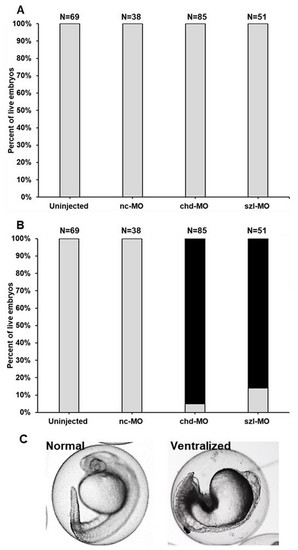- Title
-
Tris(1,3-dichloro-2-propyl) phosphate disrupts dorsoventral patterning in zebrafish embryos
- Authors
- Dasgupta, S., Vliet, S.M., Kupsco, A., Leet, J.K., Altomare, D., Volz, D.C.
- Source
- Full text @ Peer J.
|
TDCIPP-exposed embryos phenocopy embryos exposed to dorsomorphin from 0.75 to 24 hpf. (A) Representative 24-hpf images of normal embryos, delayed embryos, Class I–V levels of dorsalization, and split yolk embryos following exposure to TDCIPP or DMP. (B) Distribution of dorsalization classes following exposure to TDCIPP from 0.75 to 24 hpf. (C) Distribution of dorsalization classes following exposure to DMP from 0.75 to 24 hpf. Depending on the TDCIPP concentration (1.56 or 3.12 µM), the severity of dorsalization varied from mild (Class I) to strong (Class V). |
|
TDCIPP-induced dorsalization at 24 hpf is preceded by epiboly arrest at 6 hpf. (A) Representative images of three epiboly phenotypes (normal, delayed, and arrested) at 6 hpf. Untreated embryos are normally at the germ ring or shield stage by 6 hpf. Epiboly-delayed embryos only progress to the dome and 30% epiboly stage by 6 hpf; epiboly-arrested embryos stall at the high stage by 6 hpf. (B) TDCIPP exposure results in a concentration-dependent increase in epiboly-arrested embryos, whereas DMP-treated embryos show no epiboly defects at 6 hpf. (C) Compared to <10% for normal and delayed embryos, 76% of embryos with epiboly arrest are dorsalized at 24 hpf. |
|
szl and chd morphants do not phenocopy TDCIPP-exposed embryos at 6 and 24 hpf. (A) Knockdown of szl or chd results in no effect on epiboly initiation or progression at 6 hpf. Grey bars represent normal embryos. (B) Similar to chd morphants (95% ventralized), 84% of szl morphants are ventralized at 24 hpf. Grey bars represent normal embryos whereas black bars represent ventralized embryos. (C) Representative images of normal vs. ventralized embryos at 24 hpf. Ventralized embryos are characterized by a decrease in dorsal structures (head, eye, etc.) and expansion of ventral structures. |



